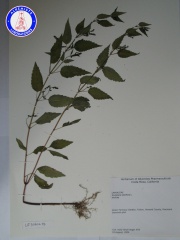Scutellaria lateriflora (flower)
From AHPA Botanical Identity References Compendium
(Difference between revisions)
(Nomenclature updated) |
|||
| Line 1: | Line 1: | ||
| − | = | + | =Nomenclature= |
| − | + | {{nomenclature | binomial=Scutellaria lateriflora | |
| − | + | |authority=L. | |
| − | + | |family=Lamiaceae | |
| − | + | |scn=skullcap | |
| − | + | |syn= | |
| + | |ayurvedic= | ||
| + | |pinyin= | ||
| + | |aka=blue skullcap; scullcap | ||
| + | |notes= }} | ||
=Macroscopic Entries= | =Macroscopic Entries= | ||
Revision as of 21:44, 14 March 2014
Contents |
Nomenclature
Scutellaria lateriflora L. Lamiaceae
Standardized common name (English): skullcap
Macroscopic Entries
|
Microscopic Entries
HPTLC Entries
Other Points of Interest
Skullcap (flowering parts) (Scutellaria lateriflora)
General Characteristics AHPA recommends in its Known Adulterants list that appropriate steps be taken to assure that this raw material is free of the noted adulterant. Contact AHPA for additional information regarding relevant analytical methods or follow this link for more information.
Reported Adulterants Germander (Teucrium chamaedrys) flowering parts.
Source: AHPA Known Adulterants [2]
Cite error: <ref> tags exist, but no <references/> tag was found

